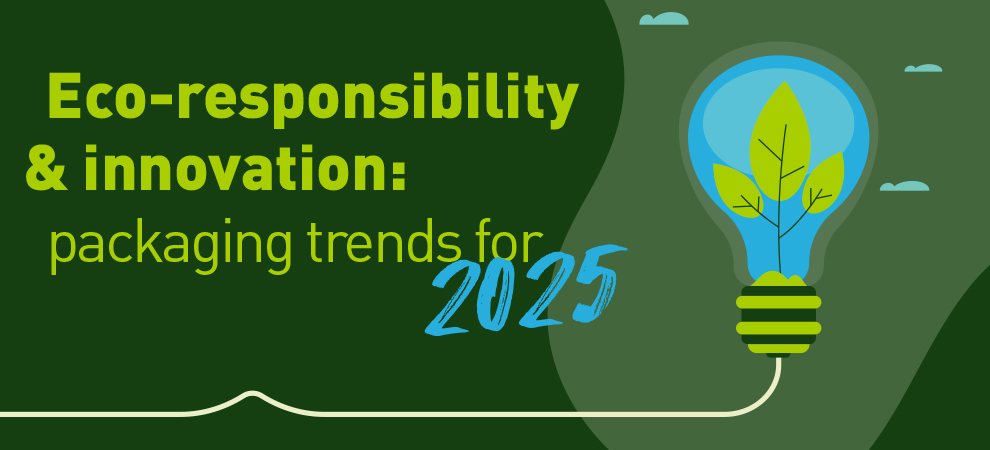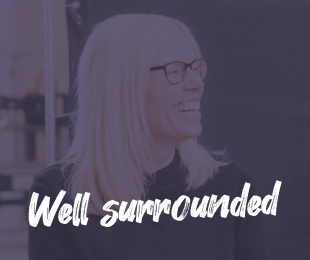
Packaging trends for 2025
Adopting eco-responsible packaging is also an opportunity for innovation and differentiation. Because in the future, packaging that fails to take its impact into account may no longer have a place on shelves or in supply chains.
2025 will be the year of innovation! And innovation will be needed to meet consumer expectations and regulatory requirements, especially on the environmental front! In this respect, the packaging sector has a decisive role to play, now and in the years to come.
Discover the exciting future of this sector through five must-see trends for the new year.

Whether influenced by European policies or driven by vision, environmental legislation is moving to the next level!
In Quebec, Extended Producer Responsibility (EPR) is gaining momentum. What are its objectives? To reduce waste at source and improve materials management. To make a significant contribution to modernizing the selective collection system, but above all to meet society’s demands in terms of recyclability, companies will have to demonstrate their compliance.
As for Canada’s Environment and Climate Change Department (ECCC), it intends to tighten the use of the recyclability symbol on packaging so that it is applied to those that are truly recyclable and recycled. At present, too many products display the famous Mobius recyclability symbol, without any infrastructure capable of handling them. In the end, they end up in the landfill. Correction of the recyclability information is therefore planned for the end of the year, with full implementation by 2030!
Also on the packaging front, the country is aiming for 50% recycled content in certain plastics (especially primary packaging) and 100% reusable, recyclable or compostable plastic packaging, also by 2030.
Fun fact: By 2025, some countries are even considering “recyclability passports” for each packaging. One thing’s for sure: a future newsletter will tell you all about it! 😉

In the pantheon of environmental measures is the reduction of GHGs, which will be translated into “ecological weight” rather than “packaging volume”. As a result, recycled materials – PCR (“Post-Consumer Recycled”) or ultralight – will be well positioned to limit their impact.
Reducing the materials used and maintaining quality in terms of efficiency and protection: minimalist design isn’t just an Instagram fad, it’s also a crucial point in packaging! Bonus? Lower packaging costs.
Far from being a constraint, this design orientation is proving to be an exciting engineering challenge. And since this year is all about innovation, intelligent solutions for optimizing formats, facilitating nesting and transportation, and limiting waste without sacrificing performance, are already emerging.
Less is more, as long as you continue to protect your product! If it arrives damaged and has to be returned for replacement, it’s even worse! Therefore, using the RIGHT quantities, neither too much nor too little – like we do at CARTIER – in the end that’s the priority.
Pro tip: Calculate the carbon footprint of your packaging with the same meticulousness as your budget: every gram counts and ends up weighing heavily on the planet (and on your brand image). In fact, our lab can do it for you, if need be 😉.

Imagine packaging that can tell you what temperature your product has been exposed to. Or a connected package that offers you real-time data on its contents, origin and even its carbon footprint (hello recyclability😉 passport) via a QR code: with the rise of connectivity and AI, these technologies are just around the corner!
Innovation will be measured not only in design, but also in traceability. The result will be better inventory management, smoother supply chains and better-informed customers. Equipping yourself with these solutions will be the key to staying in the race for optimization, warehousing and sustainability.
Little wink: With such clever packaging, one almost wonders why they haven’t learned to self-package yet!
Mechanical arms that load and unload, intelligent packaging machines that can adjust to specific needs, software that predicts demand in real time… This is not science fiction! This is our future in which robots become indispensable allies in managing packaging flows.
We can already highlight the development of machines that can work with paper, while they were historically designed for plastic film, such as the packaging machine. This is probably just the first of a long line to come. Exciting, right?
These machines are undoubtedly a significant financial commitment. However, they will also be a return on investment in time, costs and optimization. Uniform performance and precisely packaged packages: think about it!
Futuristic vision: One day, perhaps, these machines will discuss among themselves whether the packaging should be reused or recycled. We can dream, right

It’s been said time and time again: reducing GHGs and trying as much as possible to opt for green initiatives is the direction to take for the future of packaging. So it’s with great enthusiasm that we see new components with low ecological footprints arriving on the market. In this respect, we can mention PCR again. Whether used to produce film, tape or foam, it is becoming a major player in the eco-responsible industry.
Despite this encouraging news, Quebec still faces a very low circularity index (data that allows us to know the quantity of resources that are integrated into a circular economy), namely 3.5%. Not enough to shine in society, especially if we compare it to the world average (7.5%) or to the Netherlands (24.5%).
Whether it’s packaging recovery, reconditioning, cleaning or anything else, a closed circuit is often easier to implement. But we’re not going to make excuses: in Quebec, we must be better, don’t you think?
This is why, from 2025 onwards, ecological solutions will be at the heart of processes, and companies will have no choice but to adapt. This resolution should not be seen as an injunction to comply with laws and social pressures. Adopting eco-responsible packaging is also an opportunity for innovation and differentiation. Because in the future, packaging that fails to take its impact into account may no longer have a place on shelves or in supply chains.
Quick reminder: In a few years, the market will judge the product as much as its packaging. Better wrap your future well, right?

Are you interested in combining technology, eco-responsibility and efficiency? CARTIER is here to support you every step of the way. Don’t hesitate to contact us to discuss solutions that are truly adapted to your needs, and to make 2025 an exciting year!
The Cartier team also suggests
Culture & Innovation
Categories: Culture & Innovation, Écoresponsabilité
EPR: Quebec companies, be ready for 2025!
EPR: for what, for who, how and CARTIER’s contribution… We tell you all about this recycling revolution, and we’ll be happy to help you comply!
Culture & Innovation
Categories: Culture & Innovation
Supported by our team: two new duos in the spotlight
We can really count on all these fantastic people who have a clear objective: to give you access to a REAL customer experience and find a solution to your problems BEYOND your expectations.
Culture & Innovation
Categories: Culture & Innovation
CARTIER Packaging announces three new internal nominations
CARTIER Packaging is pleased to announce today three new key nominations to its team, emphasizing its commitment to developing internal talent and recognizing excellence.




